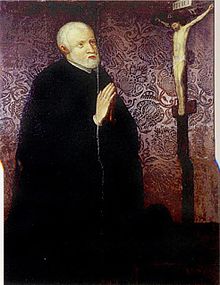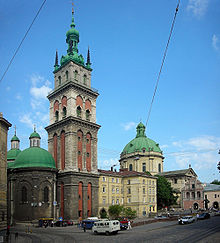- Constantine Corniaktos
-
Constantine Corniaktos
Κωνσταντίνος Κορνιακτός
Portrait of Constantine CorniaktosBorn Konstantinos Korniaktos (Κωνσταντίνος Κορνιακτός)
1517
Candia, CreteDied 1603
Lviv, Polish–Lithuanian CommonwealthResidence Lviv, Polish–Lithuanian Commonwealth Other names Konstanty Korniakt, Kornak, Korniak, Korniat, Korneadi, Korneades, Carneadi, Coretho, Carinacto[1] Ethnicity Greek[2] Known for Financing the construction of the Korniakt Palace in Lvov Lviv, [3] Spouse Anna Dzieduszycka Children Alexander Korniakt, Constantine Korniakt, Michael Korniakt, Katarzyna Korniaktówna, Sophia Korniaktówna Constantine Korniakt (c. 1517 - August 1, 1603) (Greek: Κωνσταντίνος Κορνιακτός,[4] Konstantinos Korniaktos, Polish: Konstanty Korniakt, Ukrainian: Констянтин Корніякт, Russian: Константин Корнякт, also known as Korniat, Korneadi, Korneades, Carneadi, Coretho, Carinacto)[5] was a Greek merchant[6] active in Eastern Europe and a leaseholder of royal tolls who collected customs duty on behalf of the king. During his lifetime he was the wealthiest man in Lviv and even owned numerous villages.[7] He was a wholesale merchant and founder of the Korniakt family dynasty.
Biography
Konstantinos Korniaktos was born of Greek descent[8][9][10] in the city of Candia, Crete in 1517.[11] He migrated to Constantinople at a young age, later migrating to Wallachia, and he eventually settled in the city of Lviv, where he took over a business of his older brother Michael. The kings of Poland awarded him a number of privileges and nobility.
Constantine Korniakt dealt with international trade, especially from the Ottoman Empire and countries in Germany. He became a merchant and traded in wine, cloth, cotton, honey, hides and furs and soon became very wealthy, even lending money to the kings of Poland, such as Sigismund II Augustus.
Korniakt was a patron of architecture and built a magnificent house near the market, which later was rebuilt by John III Sobieski and is now known as the Korniakt Palace. He also expanded the Wallachian church and funded its famous tower.[13] He was an ardent follower of the Orthodox Church and defended its interests maintaining friendly relations with other Christian denominations.
Around 1575 he married Anna Dzieduszycka, and soon had children. His sons were Alexander, Constantine (father of Captain Charles Francis) and Michael Korniakt, his daughters were Katarzyna Korniaktówna, Anna, whom married Jan "Gratus" Tarnowski, Sophia, who married Abraham and Catherine Hubert and after his death, she married the governor of Rus, Duke Jarema Wisniowiecki.
Constantine Korniakt died in 1603, his son subsequently sold part of his estate an land in Lviv, and his brother Alexander Korniaktow left and moved to the property he inherited from his parents in Przemysl. He was owner of three residences in the villages Sośnica, Złotowice and Białoboki, the latter being chosen for the family. In 1610 the construction of the castle began.
See also
- Korniakt Palace
References
- ^ Polska Akademia Umiejętności (1969). Polski słownik biograficzny, Volume 14. Instytut Historii PAN. p. 82. OCLC 309990360. "(Korniat, Korneadi, Korneades, Carneadi, Coretho, Carinacto) Konstanty h. Crucini (ok. 1520 — 1603)"
- ^ Malinowski, Jerzy (1993). Where East meets West: portrait of personages of the Polish-Lithuanian Commonwealth, 1576-1763 : exhibition catalogue. National Museum in Warsaw. p. 222. ISBN 837100088X. "Konstanty Korniakt Lwow merchant of Greek origin"
- ^ Adam Bujak, Jerzy Janicki (1997). Lwów. Wydawn. p. 17. ISBN 8390743612. "Korniaktowska Tower after its founder, a Cretan-born Greek named Korniakt, and classed by connoisseurs without a trace of exaggeration alongside the finest campanillas of Florence"
- ^ Panagiōtakēs, Nikolaos (1998). Anthē charitōn: meletēmata heortia sungraphenta. Istituto Ellenico di Studi Bizantini e Postbizantini di Venezia. p. 21. OCLC 301347251. "Κωνσταντίνο Κορνιακτό, ό όποιος τον είχε ..."
- ^ Polska Akademia Umiejętności (1969). Polski słownik biograficzny, Volume 14. Instytut Historii PAN. p. 82. OCLC 309990360. "(Korniat, Korneadi, Korneades, Carneadi, Coretho, Carinacto) Konstanty h. Crucini (ok. 1520 — 1603)"
- ^ Anna Benn, Hans Hoefer, Dorothy Stannard (1995). Russia: with chapters on Ukraine and Belarus. Apa Publications (HK) Ltd. pp. 306–307. ISBN 0395661676. ""Korniakt", was also built at the end of the 16th century for a well- known Greek merchant who used his influence to build a specially wide house"
- ^ I︠A︡roslav Dmytrovych Isai︠e︡vych (2006). Voluntary brotherhood: confraternities of laymen in early modern Ukraine. Canadian Institute of Ukrainian Studies Press. p. 47. ISBN 1894865030. "…the Greek merchants Constantine Korniakt and Manolis Arphanes Marinetos are added. This second redaction appeared no earlier than 1589, as wealthy Greeks began to join the confraternity at a later date, once it had expanded its activities. Korniakt was actually the wealthiest man in Lviv: he traded in Eastern, Western, and local goods, collected customs duty on behalf of the king, and owned a number of villages."
- ^ Vasylʹ Mudryĭ, Naukove tovarystvo im. Shevchenka, Shevchenko Scientific Society (U.S.) (1962). Lviv: a symposium on its 700th anniversary. New York. p. 175. OCLC 3999247. "Foreign merchants who chose Lviv as their second home, repaid the city a hundredfold: the Greek from Crete, called Koreto de Candia, whose name was popularly abbreviated into Korniakt , was the most prominent Ukrainian patrician leader in Lviv in the late 16th and early 17th century, erected a beautiful bell-tower on the pattern of Renaissance campaniles attached to the church of Assumption."
- ^ Malinowski, Jerzy (1993). Where East meets West: portrait of personages of the Polish-Lithuanian Commonwealth, 1576-1763 : exhibition catalogue. National Museum in Warsaw. p. 222. ISBN 837100088X. "Konstanty Korniakt Lwow merchant of Greek origin"
- ^ Beleckij Platon (1960). Le portrait dans la peinture ukrainienne (« Parsuna ») des XVII e et XVIII e siècles. Ecole des hautes études en sciences sociales. pp. 630–636. OCLC 295668339. "bienfaiteur de la Confrérie Constantin Korniaktos, Grec d'origine"
- ^ École pratique des hautes études (France). Section des sciences économiques et sociales (1979). Cahiers du monde russe et soviétique, Volume 20. Mouton. p. 354. OCLC 185427756. "A famous case is Constantine Korniakt at the end of the sixteenth century who was a native of Crete, became a wine merchant in Lvov, was a leaseholder of royal tolls and finally achieved nobility."
- ^ Adam Bujak, Jerzy Janicki (1997). Lwów. Wydawn. p. 17. ISBN 8390743612. "Korniaktowska Tower after its founder, a Cretan-born Greek named Korniakt, and classed by connoisseurs without a trace of exaggeration alongside the finest campanillas of Florence"
- ^ Victor E. Louis, Jennifer M. Louis (1976). The complete guide to the Soviet Union. M. Joseph. p. 184. ISBN 0718110773. "…built by Pietro di Barbona in 1574-80 for a Greek merchant, Constantine Korniakt. who financed the building of several churches in Lvov."
Categories:- 1500s births
- 1603 deaths
- People from Crete
- 16th-century Greek people
- 17th-century Greek people
Wikimedia Foundation. 2010.

